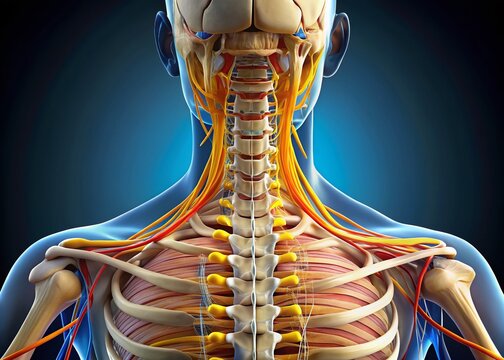Cervical Spondylosis Overview
Cervical spondylosis refers to age-related wear and tear affecting the spinal discs in your neck. These changes, which can include bone spurs (osteophytes) and the degeneration of intervertebral discs, are common with aging.
Risk Factors for Cervical Spondylosis
While age is a primary risk factor, other conditions or lifestyle elements can contribute to the development of cervical spondylosis:
- Lack of Physical Activity: A sedentary lifestyle or insufficient exercise can increase the likelihood of developing symptoms.
- Prolonged Sitting: Particularly in positions with poor posture, such as desk jobs, can place extra stress on the cervical spine.
- Obesity: Carrying excess weight can put extra stress on your neck.
- History of Neck Injuries or Surgeries: Prior trauma or medical procedures can increase the risk.
- Severe Arthritis: Chronic conditions like rheumatoid arthritis or osteoarthritis can exacerbate symptoms.
Common Symptoms
Symptoms can vary widely among individuals. Some people may experience no symptoms at all, while others may encounter:
- Neck Pain and Stiffness: Discomfort often worsens with certain movements.
- Headaches: These often originate at the back of the head, just above the neck, and can extend forward to the forehead.
- Nerve Irritation: Less commonly, cervical spondylosis can affect nerves in the neck, leading to:
- Radiating Pain: Pain that spreads to the arms or hands.
- Tingling or Numbness: Pins-and-needles sensations in the arms, hands, or fingers.
- Muscle Weakness: Loss of strength in your arms or hands.
If you experience nerve-related symptoms, consult a healthcare professional.
Diagnosis
To diagnose cervical spondylosis, your healthcare provider will:
- Ask Questions: About the history and nature of your neck issue.
- Conduct a Physical Exam: Including tests for range of motion, strength, and neurological symptoms.
- Order Further Tests (if needed): This may include X-rays, MRI, or CT scans to rule out other conditions or assess the extent of spinal changes.
Treatment Options
Cervical spondylosis is a chronic condition, meaning it requires long-term management. While it may not be completely curable, there are ways to effectively manage and reduce symptoms:
Self-Management Strategies
- Posture Awareness: Maintain good posture throughout the day. Use ergonomic furniture and avoid prolonged slouching.
- Regular Exercise: Engage in light neck exercises to improve flexibility, reduce stiffness, and increase strength. A physiotherapist can guide you through appropriate movements and stretches.
- Pain Relief: Over-the-counter pain relievers, such as paracetamol or ibuprofen, may help relieve pain and inflammation.
- Heat/Cold Therapy: Applying a hot or cold pack to the neck may help reduce pain and stiffness.
- Lifestyle Adjustments: Minimize stress and avoid activities that strain the neck, such as heavy lifting or prolonged computer use.
Medical Treatment
- Physiotherapy: This can include exercises to improve posture, flexibility, and neck muscle strength.
- Medication: Prescription medications for pain, muscle relaxants, or even corticosteroid injections in some cases.
- Surgery: Rarely required, but it may be considered in severe cases where there is compression of the spinal cord or nerves.
Work Considerations
- Time Off Work: Depending on your symptoms, you may need to take time off. However, a gradual return to work can help with recovery and building strength.
- Modifications at Work: Speak with your employer about any necessary adjustments, such as ergonomic furniture or flexible work arrangements, to minimize strain on your neck.
When to Seek Further Help
- If your symptoms do not improve after six weeks of following management advice.
- If symptoms worsen or new symptoms arise, such as significant pain, numbness, or muscle weakness.
- Consult your healthcare provider to discuss further interventions or referrals to a specialist.
Mental Wellbeing
Living with chronic neck pain can be challenging and impact mental health. Addressing stress, anxiety, and maintaining a positive mindset can aid in recovery. Support groups, counseling, or therapy may be beneficial if you’re finding it difficult to cope.
By following a comprehensive management plan, many individuals with cervical spondylosis find that their symptoms become more manageable over time, allowing them to lead fulfilling lives.







